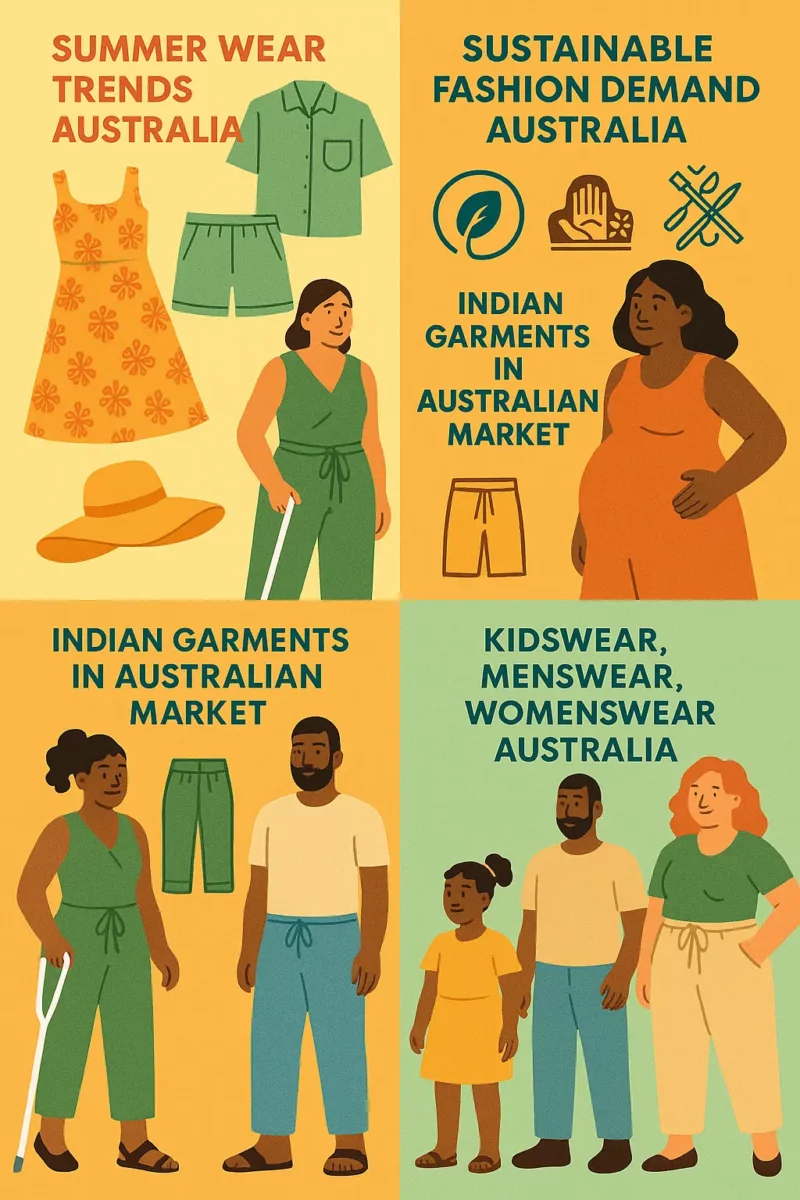Australia’s apparel market is undergoing a shift in consumer behavior and buying patterns, creating new possibilities for Indian exporters of ready-made garments (RMG). With a growing preference for sustainable, breathable, and seasonally appropriate clothing, apparel demand in Australia is rapidly becoming one of the most attractive export opportunities for Indian apparel manufacturers. The current data supports this trend: from April 2024 to March 2025, India exported $350.03 million worth of RMG to Australia, placing garments among the top five Indian export categories to the country (Source: Niryat)
This surge in apparel demand in Australia is more than just statistical. It signals a broader evolution in the way Australian consumers shop for clothes. Monthly trade reports show a 3.79% growth in apparel imports from India between February and March 2025, suggesting a pattern of sustained, long-term demand. This creates an unparalleled opportunity for Indian exporters who are willing to align with local summer wear trends in Australia, invest in quality, and innovate in product design.
Understanding Apparel Demand in Australia
To tap into this opportunity, Indian exporters must understand the unique factors shaping apparel demand in Australia. These include geography, demographics, climate, social trends, and the economic environment.
Climate-Driven Clothing Preferences
Australia’s climate is characterized by long summers, short and mild winters, and regional variations that influence seasonal clothing exports from India. The vast majority of Australians live in coastal cities where temperatures remain moderate to hot for most of the year. This makes lightweight, breathable, and UV-protective clothing a necessity rather than a luxury.
Cotton garments export to Australia is thriving due to the rising need for comfortable, climate-appropriate attire. Fabrics that allow airflow and comfort in warmer climates are particularly preferred. Products that adapt to this climate such as flowy summer dresses, breathable trousers, and lightweight outerwear, fit naturally into the daily wardrobe of Australians.
Urbanization and Fashion Awareness
Australia is one of the most urbanized countries in the world, with over 85% of its population residing in urban areas. This urban setting fosters a fashion conscious consumer base that values aesthetics, versatility, and ethical sourcing. Australian buyers are not necessarily chasing fleeting trends; instead, they favor timeless styles with a modern twist. Quality, durability, and cultural relevance are major selling points.
The Rise of Sustainable Fashion
Perhaps the most important trend in Australia’s fashion industry is the rise of sustainable fashion demand in Australia. Consumers are increasingly concerned with how and where their clothes are made. They seek transparency in production processes, fair labor practices, and eco-friendly manufacturing.
Indian garments in the Australian market that showcase organic cotton usage, employ artisan weavers, and use water-efficient dyeing techniques are well positioned for success. Sustainable fashion demand in Australia opens new doors for Indian exporters who focus on traditional craftsmanship and environmentally conscious processes.
What Type of Clothes Sell Well in Australia
Indian apparel has found favor among Australian consumers in several high-performing categories. Exporters asking, “What type of clothes sell well in Australia?” should focus on the following:
Women’s Clothing
- Cotton and linen dresses are suitable for warm weather
- Wrap skirts, tunics, and tops for both casual and semi-formal settings
- Kaftans and loungewear that double as resort wear
- Maternity wear made with soft, breathable fabrics
- Fusion fashion such as kurtis with western silhouettes
Men’s Clothing
- Linen shirts and chinos for a polished yet comfortable look
- Light jackets and overshirts suitable for layering in mild winters
- Casual blazers and kurtas for multicultural events or business-casual attire
Kidswear
- Organic cotton outfits with playful prints and safety-first design
- Festive Indian clothing tailored for Indian-Australian children
- Eco-friendly school uniforms
Loungewear and Athleisure
- Cotton-based tracksuits and joggers with minimalist designs
- Stretchable yoga wear made from natural fibers
- Unisex co-ords that suit remote work and casual lifestyles
Trending Apparel for Australian Consumers: 2025 Outlook
1. Dominance of Summer Wear
Summer wear trends in Australia dominate consumer spending for most of the year. Seasonal clothing exports from India must focus on items that thrive in Australia’s extended summers.
Key Products:
- Hand-block printed cotton dresses
- Linen co-ord sets and tunics
- Cotton jumpsuits
- Drawstring trousers and palazzos
- Wide-brimmed cotton hats and scarves
2. Growth in Ethical & Artisan-Made Fashion
Sustainable fashion demand in Australia is rising rapidly. Consumers want to know the story behind their clothes. Products made using low-impact techniques, ethical labor, and sustainable textiles are more desirable.
3. Functional & Transitional Fashion
Due to climate variability, Australian buyers prioritize versatile clothing. Transitional wear that works in both summer and mild winter seasons has high ROI potential.
4. Inclusivity in Apparel Design
Indian garments in the Australian market that cater to plus-size, adaptive clothing, and maternity wear are increasingly welcomed. Kidswear, menswear, and womenswear in Australia are all shifting towards inclusivity.

Fashion Retail Statistics Australia: Why Apparel Exports Matter
Fashion retail statistics in Australia show that the country’s apparel market exceeds $20 billion in annual value. Online sales account for over 35% of that revenue, and digital first strategies continue to gain momentum.
In the latest export figures, ready-made garments made up 4.08% of India’s total exports to Australia. With continuous monthly growth and clear upward trends in buyer interest, Indian garments in the Australian market are positioned for strong and stable growth.
Opportunities for Indian Fashion Exporters in 2025
The year 2025 presents wide-open opportunities for Indian fashion exporters. Here’s why:
1. Expanding Cotton Garments Export to Australia
Australia’s preference for breathable and organic fabrics has led to increased cotton garment exports to Australia. Products like women’s dresses, kidswear sets, and men’s shirts made from Indian cotton are gaining widespread appeal.
2. Growing Sustainable Fashion Demand in Australia
Indian exporters focused on organic, artisanal, and environmentally friendly fashion have a major competitive edge. Sustainable fashion demand in Australia offers exporters a premium pricing model and loyal buyer segments.
3. Embracing Diversity in the Australian Market
Australia’s multicultural population is highly receptive to Indian fashion. Whether it’s tunics, embroidered jackets, or relaxed-fit loungewear, Indian garments in the Australian market are no longer limited to the diaspora.
4. High Potential in Niche Segments
Categories like maternity wear, adaptive clothing, and eco-friendly school uniforms are growing. Exporters who address these needs will find strong first-mover advantages.
Fashion Product Categories with High ROI in Australia
Based on trade performance and buyer feedback, the following categories offer the best returns:
| Category | Features | Buyer Demographics |
|---|---|---|
| Women’s Casualwear | Breathable, stylish, cotton-linen blends | Urban women, age 20–40 |
| Kidswear | Organic fabrics, playful yet durable | Eco-conscious parents |
| Menswear | Versatile styles, relaxed fits | Professionals, 25–45 |
| Loungewear & Athleisure | Minimalist, soft, comfortable | Remote workers, Gen Z |
| Transitional Wear | Layering-friendly, sustainable materials | Nationwide appeal |
Exporters looking for fashion product categories with high ROI in Australia should tailor their offerings to these segments.
Buyer Preferences for Clothing in Australia
Understanding buyer preferences for clothing in Australia is essential for any export strategy.
Key Preferences:
- Value over volume: Australians prefer quality over quantity.
- Comfort is non-negotiable: Soft, breathable fabrics and good fits are a must.
- Ethical sourcing: Consumers want to know how and where garments are made.
- Fashion with purpose: Storytelling around tradition or sustainability resonates.
- Right timing: Export schedules must align with Australia’s fashion retail calendar.
Exporters that align their strategy with these buyer preferences for clothing in Australia can build trusted long-term partnerships.
Strategic Recommendations for Export Success
1. Conduct Market Research and Test Launches
Test new styles and collections aligned with trending apparel for Australian consumers via small batch exports.
2. Ensure Compliance and Labeling
Meet all Australian regulations for textile labeling, safety, and care instructions.
3. Focus on Sustainable Packaging
Eco-friendly, biodegradable, or recyclable packaging boosts consumer trust.
4. Leverage Trade Fairs and Buyer Platforms
Participate in trade events to meet fashion retailers and gain visibility.
5. Establish Collaborative Partnerships
Build relationships with retailers and boutique brands. Consider co-developing seasonal lines tailored for Australian buyers.
Final Takeaway: India’s Apparel Exporters are Poised for Growth
The current momentum in apparel demand in Australia, combined with evolving consumer needs, creates a perfect storm of opportunity. Indian garments in the Australian market are gaining more attention for their comfort, craftsmanship, and climate adaptability.
By focusing on trending apparel for Australian consumers, aligning with summer wear trends in Australia, and delivering fashion product categories with high ROI in Australia, Indian exporters can position themselves as indispensable players in the fashion retail ecosystem.
From cotton garments export to Australia to inclusive kidswear, menswear, and womenswear Australian markets, the next few years promise exponential growth for Indian apparel. With the right timing, ethical approach, and strategic vision, Indian exporters are ready to lead the way.
For those still wondering, “Which Indian garments are popular in Australia?”, the answer lies in quality, sustainability, and cultural resonance. And the biggest question, “What type of clothes sell well in Australia?” is no longer a mystery, comfort-driven, climate-compatible, and ethically made clothes are winning the Australian market, one garment at a time.
FAQs
Lightweight cotton dresses, linen shirts, organic kidswear, athleisure, and transitional wear that suit Australia’s climate and lifestyle.
Fashion retail statistics Australia show the market exceeds $20 billion annually, with strong online growth and consistent monthly increases in imports from India.
Women’s casualwear, kidswear in organic cotton, menswear, loungewear & athleisure, and transitional seasonal clothing exports from India.
Expanding sustainable product lines, catering to multicultural demand, and targeting niche categories like plus sizes and adaptive clothing.









